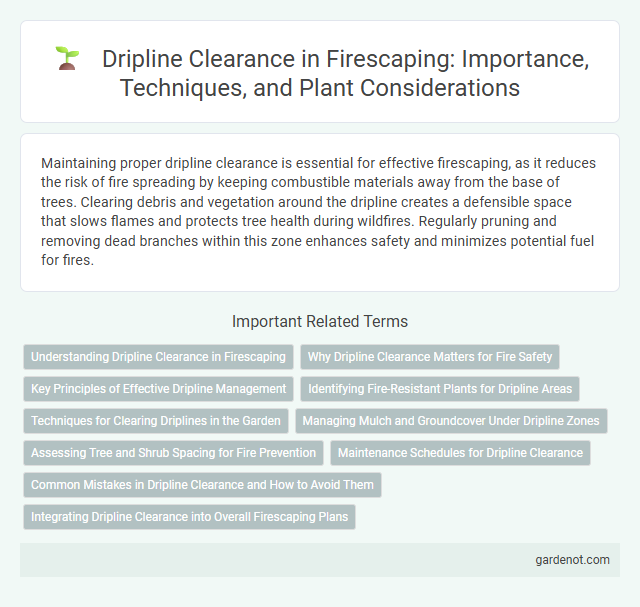Maintaining proper dripline clearance is essential for effective firescaping, as it reduces the risk of fire spreading by keeping combustible materials away from the base of trees. Clearing debris and vegetation around the dripline creates a defensible space that slows flames and protects tree health during wildfires. Regularly pruning and removing dead branches within this zone enhances safety and minimizes potential fuel for fires.
Understanding Dripline Clearance in Firescaping
Dripline clearance in firescaping involves maintaining a safe distance between vegetation and structures to reduce wildfire risk by preventing embers from igniting flammable materials. This practice focuses on removing or spacing out plants and debris within the dripline area--the outer edge of a tree's canopy where water drips off--to minimize fuel continuity. Proper dripline clearance enhances defensible space, improves fire resistance, and protects property against wildfire exposure.
Why Dripline Clearance Matters for Fire Safety
Dripline clearance is crucial for fire safety as it prevents the accumulation of flammable debris near the outer edge of tree canopies, reducing the risk of ground fires spreading to tree crowns. Maintaining at least a 3 to 6-foot clearance around the dripline minimizes fuel for wildfires, helping to protect structures and landscapes from fire damage. Proper dripline clearance also facilitates firebreak creation, improving the chances for firefighters to control and contain wildfires effectively.
Key Principles of Effective Dripline Management
Maintaining a clear dripline by removing flammable vegetation within a minimum radius of 10 feet from trees significantly reduces wildfire risks. Utilizing hardscape materials such as gravel or stone under dripline areas enhances fire resistance and minimizes combustible debris accumulation. Regular inspection and pruning to prevent dense canopy growth above the dripline further ensure optimal fire protection and landscape safety.
Identifying Fire-Resistant Plants for Dripline Areas
Selecting fire-resistant plants for dripline clearance significantly reduces the risk of wildfire ignition near structures. Ideal plants include succulents, native oaks, and low-growing shrubs with high moisture content and low resin levels. Incorporating these species within 30 feet of buildings creates an effective fuel break, enhancing fire safety and protecting property.
Techniques for Clearing Driplines in the Garden
Effective dripline clearance techniques include removing fallen leaves, debris, and dead vegetation within a 3 to 5-foot radius around plant bases to reduce fire fuel. Utilizing hand tools such as rakes, pruners, and leaf blowers ensures precision and minimizes damage to the root zone. Regular maintenance and monitoring optimize fire resistance by preventing combustible materials from accumulating along driplines.
Managing Mulch and Groundcover Under Dripline Zones
Maintaining proper clearance of mulch and groundcover within dripline zones is essential for fire-resistant landscaping, reducing the risk of flame spread by minimizing combustible materials near tree trunks. Managing this space involves removing excess mulch and dense groundcover to create a defensible area, allowing moisture retention without providing fuel for wildfires. Effective dripline clearance supports tree health and improves overall fire protection by limiting continuous vegetation that facilitates fire movement.
Assessing Tree and Shrub Spacing for Fire Prevention
Assessing tree and shrub spacing within dripline clearance is a crucial step in firescaping to reduce wildfire risk. Maintaining adequate horizontal and vertical separation between vegetation limits fuel continuity, preventing fire from easily spreading across tree canopies and dense shrubs. Optimal spacing, generally three times the height of vegetation between trees and a minimum of 10 feet between limbs and ground, creates defensible space and enhances property protection.
Maintenance Schedules for Dripline Clearance
Regular maintenance schedules for dripline clearance are essential to prevent accumulation of combustible debris near structures in firescaping efforts. Clearing dripline zones at least twice annually reduces wildfire risk by removing flammable vegetation and dead plant material within the critical perimeter around buildings. Effective maintenance involves inspecting and clearing at the start and end of the fire season to maintain optimal defensible space.
Common Mistakes in Dripline Clearance and How to Avoid Them
Common mistakes in dripline clearance include leaving flammable debris or vegetation within the dripline radius, which increases fire risk and hinders effective defensible space. Overlooking the proper maintenance of dripline clearance by neglecting seasonal cleanup reduces its effectiveness in protecting structures from wildfires. To avoid these errors, regularly remove dead leaves, branches, and other combustible materials within at least 10 feet of the dripline and schedule seasonal inspections to maintain optimal fire-resistant conditions.
Integrating Dripline Clearance into Overall Firescaping Plans
Integrating dripline clearance into overall firescaping plans enhances wildfire defense by creating a defensible space around structures and vegetation. Maintaining a 3-5 foot clearance zone devoid of flammable materials directly beneath tree canopies reduces ember ignition risks and interrupts fire spread pathways. Strategic placement of dripline clearance complements other firescaping elements such as ember-resistant plants, hardscaping, and proper irrigation, optimizing landscape resilience against wildfire threats.
Dripline clearance Infographic

 gardenot.com
gardenot.com